| Article ID | Journal | Published Year | Pages | File Type |
|---|---|---|---|---|
| 585732 | Journal of Hazardous Materials | 2006 | 6 Pages |
Alachlor can be recalcitrant when present at high concentrations in wastewater. Ferrate oxidation was used as a pretreatment to improve its biodegradability and was evaluated by monitoring alachlor elimination and removal of CODCr (chemical oxygen demand determined by potassium dichromate) during the oxidation process up to a value compatible with biological treatment. Ferrate oxidation resulted in elimination of alachlor followed by degradation of its intermediates. High pH suppressed alachlor removal and CODCr removal due to the low redox potential of ferrate ions. Although alachlor can be totally eliminated within 10 min under optimized conditions (alachlor, 40 mg l−1; ferrate:alachlor molar ratio, 2; and pH 7.0), its complete mineralization cannot be achieved by ferrate oxidation alone. Alachlor solution treated by ferrate for 10 min inhibited an up-flow biotreatment with activated sludge. The biodegradability of ferrate-pretreated solution improved when the treatment was increased to 20 min, at the point of which BOD5/CODCr ratio of the treated solution was increased to 0.87 from 0.35 after 10 min treatment. Under optimized conditions, ferrate oxidation for 20 min resulted in total elimination of alachlor, partial removal of CODCr and the ferrate-treated solution could be effectively treated by the up-flow activated sludge process.
